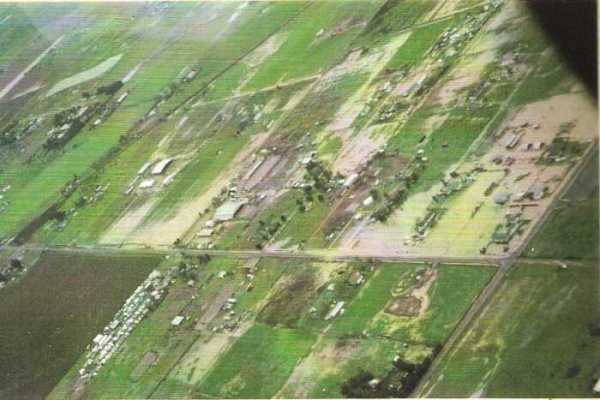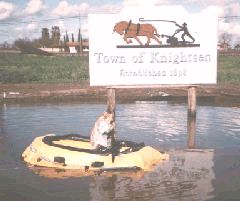LARGE ANIMAL RESCUE SKULL SESSION
|
THE TOWN NATURE TRIED TO DROWN
HOW THE INCIDENT WAS RESOLVED |
|
This problem is based on a real scenario and is presented for a "Skull Session" discussion in the Technical Large Animal Emergency Rescue Facebook Group.
Location The incident has occurred in a small California town in the San Joaquin River Delta. Date and Time Some time in the middle of the night. Incident Details Heavy rains and high river levels had both public agencies and private citizens patrolling the nearby river levees for seeps, boils and potential overtopping. However unbeknownst to them, a great deal of runoff entered the complex system of irrigation canals that served the area's agricultural operations. Irrigation system canals and pipes start large, then diminish in size as they branch out to serve agricultural water users. This unintended influx of water quickly overran the smaller waterways and spilled into town. The area's drainage was not equipped to handle this inflow so the water collected and rose.

Many residents woke up to several feet of standing water. The flooded properties included private properties with livestock and a couple of horse boarding facilities. Some roads were overtopped with water but most were safe to travel with caution. Large animals were standing in the water. Smaller animals were clinging to whatever they could get hold of. The primary livestock relocation center was impacted and unavailable. The county fairgrounds had suffered significant damage from an overflowing creek and was unavailable. Local hay supplies (haystacks) were standing in water. Stored farm chemicals and fuels were impacted. In many places there was an oily sheen on the water. Some properties were not completely flooded, having small portions of ground that were above the water line. It was evident that this issue was going to take weeks to resolve. Skull Session Questions
Group Feedback. Feedback centered on some solid, basic principles.
This incident was somewhat unique as the major flood risk from the San Joaquin River did not involve this community. Vast areas along the river were under a flood watch due to extreme pressure on the river levees and a couple of other counties were having significant issues. Instead, this particular community was flooded by water that spilled into the irrigation district. Given the more serious flooding and genuine threats of levee breaches affecting other towns and cities, this particular flood barely made a blip in the EOC radar. Most potential rescuers were busy dealing with their own issues. Support from the county was limited to a truck load of sandbags. The evacuation team consisted of two people and one 4-horse trailer, assisted by a couple of volunteers from the local fire department. All the preplanned relocation facilities were above the river zone, but were flooded. Initial Actions I owned a boarding and training stable that would have been one of the collection points and I was also under water. My first action was to move the horses to one small plot of high ground and build a "goat dock" out of pallets and plywood so that the small goat herd wouldn't drown. Next I called the other facilities and volunteers. The other relocation points were dealing with their own problems. The county fairgrounds were out of commission. Shelter options in nearby San Joaquin County were at risk of a major levee breach flood. We had to deal with the problem locally. Our normal communications support team was assigned elsewhere. Animal Services was inundated with calls. The usual transport volunteers were busy dealing with their own issues and those of their immediate neighbors. We informally decided to let each "block" (usually consisting of a group of parcels in a 640 acre section) assess and manage itself. I contacted some skydivers and hastily hired an airplane to fly overhead with a digital camera so we could identify flooded areas and zones where animals could be relocated. The water was still coming in. Once we had a sense as to which areas were not affected and weren't also at risk of a levee failure, we identified parcels where we had high confidence that animals could safely be relocated. Initial assessments were conducted via a telephone tree of area livestock owners and horse facilities. From that assessment we were able to determine who could shelter in place, who needed animals relocated and who had capacity to take additional animals. (It's always a good idea to have accurate telephone lists in advance of an emergency.) Priorities were established and the animals most urgently needing relocation were moved to available space. Additional properties were available but needed repairs to shelters and fencing. Volunteers made hasty repairs and remaining animals were relocated. Once the animals in obvious need were relocated, a secondary search for animals was conducted. A few animals that were overlooked in the initial effort were discovered and were placed in appropriate locations. Once local holding capacity was determined, the animals were relocated within and around the community so that owners could maintain control over and care and maintenance of their animals. Animal owners were put in direct contact with Foster caregivers whereupon the owners were then responsible to see to the welfare and needs of their relocated animals. A rough inventory was made of available water troughs, owners' names were painted on them and they were taken to locations where animals were being sheltered. Other supplies such as garden hoses were rounded up to provide water from functioning wells to water toughs where animals were being temporarily held.
Sand bags and portable gasoline pumps were used for the recovery of minimally flooded pastures and corrals. In some instances animals could return within a week. Other animals were sheltered for over a month. The town's volunteer fire station was the main clearinghouse for information. Shortly before this incident, a flood in another county in the region resulted in the deaths of several hundred cattle and other livestock. In this Skull Session event, no animals were lost and all were relocated before they suffered any significant ill effects from exposure to the flood waters. Go to Skull Session IndexReturn to the Strike Team LRTC Page |
This material is intended for the use of the Technical Large Animal Emergency Rescue (TLAER) Facebook Group. TLAER is a trademark of Technical Large Animal Emergency Rescue. |
 Hay barns were flooded but undamaged hay (that stored above the water line) was loaded onto a flat trailer and distributed to shelter locations. All wet hay was subsequently removed from the barns as it could later pose a fire hazard. Small wading pools were used to float feed supplies to high ground where animals were held.
Hay barns were flooded but undamaged hay (that stored above the water line) was loaded onto a flat trailer and distributed to shelter locations. All wet hay was subsequently removed from the barns as it could later pose a fire hazard. Small wading pools were used to float feed supplies to high ground where animals were held.